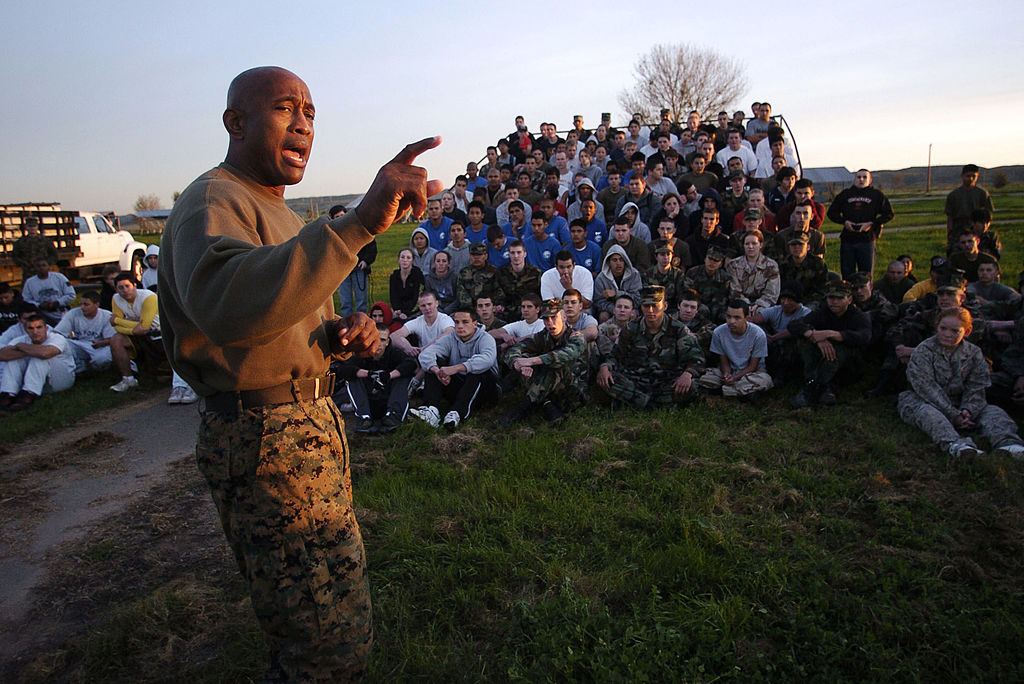
By Jonah Walters
From The National Network Opposing the Militarization of Youth (NNOMY)
Military recruiters understand that widespread joblessness is good for enlistment. They celebrate the arrival of “Sergeant Hard Times,” recognizing that misery is the best motivator.
The coronavirus crisis has been a double-edged sword for military recruitment in the United States. On the one hand, the tightening of the labor market contributed to higher rates of retention than the Army brass expected, meaning that many soldiers decided to reenlist this spring rather than pursue civilian employment when their terms of service expired. On the other hand, recruiting stations across the country have had to shut down to comply with social distancing guidelines, limiting recruiters’ access to young people and inhibiting the “kneecap-to-kneecap” conversations recruiters widely acknowledge to be essential to their work.
Less than one percent of the Armed Forces’ target demographic — seventeen- to twenty-four-year-olds — is actively interested in a military career. After a “kneecap-to-kneecap” encounter with a recruiter, whether at a recruiting station or a school event, probability of enlistment climbs to more than 50 percent, according to the Army.
The reasons for this have been well-documented by anti-recruitment activists for decades. Recruiters, who are expected to meet regular enlistment quotas, aggressively pursue young people who express interest, generally attempting to separate them from parents, teachers, counselors, and others who might advocate for civilian careers.
Since the end of the Obama presidency, Army leaders have insisted upon the need for a 500,000 member Army, establishing quarterly recruitment benchmarks in an attempt to reach that goal. (Last year, there were about 470,000 active-duty Army soldiers, down from a recent peak of about 560,000 in 2010, during Obama’s Afghanistan surge.) The recruitment drive is part of an effort to transition the US military away from its focus on “small wars” and counterinsurgency efforts in preparation for a possible “great power” conflict with Russia or China.
The Army missed its recruiting goal by about 6,500 enlistments at the end of 2018, its first missed target since 2005, during the Iraq War. The Army responded by adding 770 new recruiters and forming virtual recruiting teams (VRTs) for each of its recruiting battalions nationwide. VRTs, which one colonel characterizes as “force multipliers,” are tasked with identifying possible recruits using social media.
The Pentagon also launched a national recruiting strategy dubbed “Focus 22,” which aims to shift the geography of recruitment away from Southern and Midwestern areas (many of which are experiencing population decline) and towards a list of twenty-three American cities with high numbers of black and Latino young people. (Presumably they added a city after determining the name of the initiative.) City governments have generally been quite happy to collaborate with military recruiters on this program.
In Baltimore, city officials opened all forty-four of the city’s public recreation centers to the armed forces, allowing the military to install its “March2Success” software on public computers. March2Success is a program that purports to assist students studying for college admissions tests; it also captures personal information and helps recruiters identify students to target for recruitment.
Perhaps most bizarrely, the Army developed a set of sixty-five neighborhood profiles, or “segmentations,” to assist recruiters in cities around the country with their messaging. The Army understands downtown Baltimore, for example, to be a “Modern Urban Mix” segmentation. Recruiters are reminded that, in segmentations such as this one, residents enjoy “urban adult contemporary music” and are interested in boxing.
The first year of Focus 22 was a success. More than 68,000 new recruits joined the ranks of the armed forces in 2019, with military officials acknowledging that student loan debt was likely the biggest factor driving military recruitment that year.
Focus 22 continues this year, although the ongoing coronavirus crisis poses significant barriers to normal recruiting techniques. The military has met the moment by transitioning to a detailed digital recruitment plan, intensifying its focus on social media outreach and taking advantage of school closures to promote March2Success to home learners.
The Marine Corps recently organized a truly bizarre virtual recruiting event, featuring Second Life-style avatars wandering clumsily around a digital job fair. The Pentagon also has big plans for its Army Esports Team, formed just last year as a possible outreach and recruiting engine.
It remains to be seen whether the armed forces will hit their benchmarks this year. It’s no secret that the Pentagon deliberately targets low-income black and Latino youth for recruitment, and that, especially in recent years, recruiters have begun to see poor neighborhoods in liberal cities as prizes ripe for the plucking.
The purpose of Focus 22, according to its Army architects, is to provide a pathway into military careers for young people in poor urban neighborhoods without a lot of employment options. Recruiters aim to accomplish this, in part, by introducing the military to people who have not yet encountered it as an institution in their everyday lives.
By my count, Army National Guardsmen deployed to assist police in repressing this month’s Black Lives Matter protests in fifteen of the Pentagon’s twenty-three target cities. (Cities where the National Guard deployed and that appear on the Pentagon’s list are Atlanta, Boston, Baltimore, Chicago, Cleveland, Dallas, Denver, Kansas City, Los Angeles, Minneapolis, Oklahoma City, Phoenix, Sacramento, Seattle, and St. Louis.)
After the events of the past month, young black residents of Minneapolis and other cities need no introduction to the military as an institution. Many of those who the Pentagon may have hoped to recruit this summer have by now already encountered the military — not in the form of a smiling recruiter (or his online avatar), but as a menacing interloper in their own neighborhoods.
U.S. Army plans massive recruiting drive for summer
By Brian Niemietz
From New York Daily News | Original Article (5/22/2020)
As nationwide unemployment figures reach record highs, the Army is offering career-seekers an opportunity to be all they can be.
The U.S. Army plans to launch a major recruiting drive between June 30 and July 2. The initiative, called Army National Hiring Days, was reportedly pitched to the Army’s service secretary and chief of staff earlier this month. It will begin shortly after the storied military branch celebrates its 245th birthday on June 14.
According to the Army Times, the push to beef up the number of soldiers in uniform follows a springtime of low recruitment, brought about by the coronavirus pandemic lockdown.
“We are engaging in the ‘Focus 22’ and we’re driving our message for people to either go into the recruiting stations or go to GoArmy.com,” Army recruiting commander Maj. Gen. Frank M. Muth told the military site.
Muth, whose spearheading the drive, said the “22” refers to the number of cities the initiative tends to target. Those cities include New York, Boston, Chicago and Seattle, which have a large Gen Z population that might not ordinarily consider military careers.
He intends to communicate that while up to 20% of the Army is boots on the ground and planes in the air, “a larger portion is the tech, and the help, and the engineers and the logistics.”
Military brass would utilize tools including Zoom or and Microsoft Teams to reach potential recruits. Traditional recruiting efforts have focused on the South and Midwest.
Enlistment had reportedly been strong before the pandemic shutdown recruiting stations and forced the process onto the internet. The Army had signed up 2,200 more recruits by March 2020, matching the total for the same time frame in 2019. Recruiters now find themselves roughly 4,000 contracts short of their projected goal.
The nation’s soaring unemployment numbers could play to the advantage of the military, according to the Army Times, which says Army retention is about 15 percent higher than expected right now.
Gen. Muth feels the Army National Hiring Days event could be an indicator as to how much confidence young people have in the job market’s odds of bouncing back. Times of high unemployment reportedly make military service a more tempting option for some.
“I think we’ll … have an indication by mid-July, beginning of August if things really start to change,” he said.
